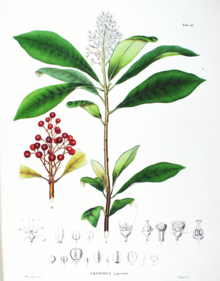Skimmia japonica
| Skimmia japonica | ||||||||||||
|---|---|---|---|---|---|---|---|---|---|---|---|---|

Skimmia japonica - budded inflorescences of a cultivated form |
||||||||||||
| Systematics | ||||||||||||
|
||||||||||||
| Scientific name | ||||||||||||
| Skimmia japonica | ||||||||||||
| Thunb. |
Skimmia japonica is a native to East Asia plant species from the genus of skimmia ( skimmia ) in the family of the Rutaceae (Rutaceae). A large number of cultivated forms of this type are popular ornamental plants .
distribution
The home of Skimmia japonica is Japan , Korea and China . The plants grow there as undergrowth in forests.
description
Skimmia japonica grows as an evergreen shrub with heights of up to 7 m, although specimens in temperate latitudes rarely reach more than 1.5 m. The leathery leaves are more or less rosettes at the end of the branches. They are 7 to 10 cm tall and fresh green on top; the underside is tinted more yellow.
The plant is dioecious ( dioecious ), although there are also hermaphrodite varieties. The white flowers are in terminal panicles and have a sweet smell (see synonym Skimmia fragrans , from fragrans "fragrant"). The inflorescences with the flower buds are reddish to brownish in color and already have an ornamental value. They are often formed in autumn, while the flowers do not open until spring. The spherical, single-seeded berries are strikingly red and about the size of a pea.
The number of chromosomes is 2n = 30 or 60.
Toxicity
The whole plant is considered to be less poisonous.
Main active ingredients: in the wood of the branches Skimmin, in the leaves Sosolin, Dictamin, Skimmianin, Edulin and (+) - Platydosmin.
Symptoms of poisoning: Skimmiamin potentiates the effect of adrenaline, sensitizes the spinal reflexes, relaxes the smooth ones and increases the tone of the striated muscles.
Systematics
Synonyms for the species are Skimmia fragans Carrière and Skimmia oblata T. Moore (1821–1887). Depending on the author, a distinction is made between the following varieties or forms:
- Skimmia japonica var. Japonica (syn .: Skimmia japonica var. Veitchii (Carriere) Rehder , skimmia oblata var. Veitchii (Carriere) Carrière , skimmia veitchii Carrière ): It is used in Japan, Taiwan and on Sakhalin ago.
- Skimmia japonica var. Intermedia Komatsu (Syn .: Skimmia japonica f. Repens (Nakai) H. Hara , Skimmia repens Nakai ): It occurs in Japan, on Sakhalin and on the Kuriles .
Cultivated forms
A variety of cultivated forms has emerged; a selection follows:
- 'Emerald King',
- 'Fragrans',
- 'Keessen',
- 'Kew White',
- 'Nymans',
- 'Rubella',
- 'Rubinetta',
- 'Ruby Dome',
- 'Veitchii', also called 'Foremannii',
- 'Wanto' as well
- 'White Gerpa'.
Culture
If the plant is cultivated as a houseplant , it is difficult to guarantee that the fruit will set: Since the plant is dioecious, male and female specimens must be kept together, and pollination usually takes place by insects and must be artificially combined with the when cultivated in closed rooms Brush done.
Japanese Skimmias are more or less frost hardy depending on the variety. Almost all varieties can be cultivated outdoors in Central Europe. They also grow in shade or partial shade and, like rhododendrons , like humus-rich, slightly acidic soil.
literature
- Rob Herwig: Parey's Houseplants Encyclopedia . Paul Parey Verlag, Berlin and Hamburg 1983, ISBN 3-489-61024-5 .
- Hayashi Yasaka: Nihon-no Jumoku . Yama to Keikoku Sha, Tokyo 1985, ISBN 4-635-09017-5 .
- L. Roth, M. Daunderer, K. Kornmann: Poison plants plant poisons, 6th revised edition, 2012, Nikol-Verlag, ISBN 978-386820-009-6
Individual evidence
- ↑ Skimmia japonica at Tropicos.org. In: IPCN Chromosome Reports . Missouri Botanical Garden, St. Louis
- ↑ a b c Skimmia in the Germplasm Resources Information Network (GRIN), USDA , ARS , National Genetic Resources Program. National Germplasm Resources Laboratory, Beltsville, Maryland. Retrieved June 11, 2017.
Web links
- Brief description at Plants for a Future (English)


